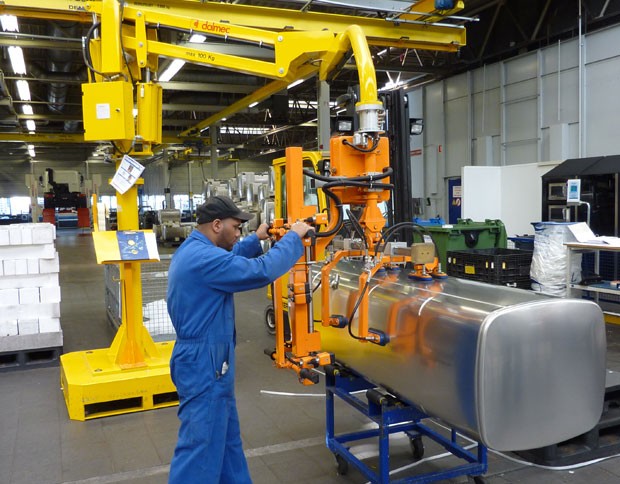Mercury Handling Safety: Protocols and Precautions in Laboratory Settings – The Safety Master

Forklift Safety: Guidelines for Operating and Working Around Forklifts on Construction Sites – The Safety Master
February 9, 2024
Manual Material Handling: Techniques for Lifting and Moving Heavy Loads Safely – The Safety Master
February 12, 2024Introduction
Mercury, a silver liquid metal with extraordinary properties, has long been a staple in various laboratory experiments and industrial processes. However, its remarkable properties come hand in hand with significant risks to human health and the environment. In laboratory settings, where mercury is frequently used, it becomes imperative to adhere to stringent safety protocols to mitigate potential hazards effectively.
1. Understanding Mercury
Mercury, also known as quicksilver, is a naturally occurring element with the chemical symbol Hg. It is the only metal that exists in a liquid state at room temperature. Due to its high surface tension and low viscosity, mercury forms droplets rather than spreading thinly like water. Commonly used in thermometers, barometers, and electrical switches, mercury’s unique properties make it invaluable in various scientific applications.
1.1. Properties of Mercury
Mercury exhibits unique characteristics such as high density, thermal conductivity, and electrical conductivity. Its ability to amalgamate with other metals allows for the creation of stable amalgams used in dental fillings and gold extraction processes.
2. Risks Associated with Mercury
Despite its usefulness, mercury poses significant risks to human health and the environment. Exposure to mercury vapor or ingestion of mercury compounds can lead to severe health issues, including neurological damage, kidney failure, and respiratory problems. Furthermore, mercury contamination in the environment can accumulate in the food chain, posing risks to wildlife and humans.
2.1. Health Hazards
Inhalation of mercury vapor can cause symptoms such as headaches, nausea, and respiratory irritation. Prolonged exposure may result in neurological disorders, tremors, and even irreversible brain damage. Additionally, ingestion of mercury compounds can lead to gastrointestinal distress and organ damage.
3. Importance of Proper Handling
Given the potential risks associated with mercury exposure, ensuring proper handling procedures is paramount in laboratory settings. Strict adherence to safety protocols not only protects laboratory personnel but also minimizes environmental contamination.
3.1. Mitigating Environmental Impact
Improper disposal of mercury-containing materials can lead to contamination of soil and water sources, posing long-term environmental risks. By implementing proper handling and disposal practices, laboratories can reduce their environmental footprint and contribute to sustainability efforts.
4. Laboratory Safety Protocols
Laboratories must establish comprehensive safety protocols to minimize the risks associated with mercury handling. From personal protective equipment to spill response procedures, these protocols are essential for maintaining a safe working environment.
4.1. Personal Protective Equipment (PPE)
When working with mercury, laboratory personnel must wear appropriate PPE, including gloves, goggles, and lab coats, to minimize direct contact and inhalation exposure. Respiratory protection may also be necessary when handling mercury in confined spaces or areas with poor ventilation.
4.2. Containment and Storage
Mercury should be stored in tightly sealed containers made of chemically resistant materials to prevent leaks and spills. Additionally, laboratories should implement secondary containment measures to contain any accidental releases and minimize environmental contamination.
4.3. Handling Procedures
Strict adherence to handling procedures is essential to minimize the risk of exposure to mercury. Personnel should use designated equipment, such as syringes or transfer pipettes, to handle mercury safely. Spills should be promptly cleaned up using appropriate absorbent materials and disposed of according to regulatory guidelines.
5. Spill Response and Cleanup
Despite precautionary measures, mercury spills may still occur in laboratory settings. Prompt and effective response is crucial to minimize exposure and environmental contamination.
5.1. Immediate Response
In the event of a mercury spill, laboratory personnel should evacuate the area and restrict access to prevent further exposure. Spill kits containing absorbent materials, gloves, and protective gear should be readily accessible for quick response.
5.2. Cleanup Procedures
Cleanup of mercury spills should be conducted by trained personnel wearing appropriate PPE. Contaminated materials should be carefully collected and placed in designated hazardous waste containers for proper disposal. Decontamination of affected surfaces should be thorough to prevent residual contamination.
6. Training and Education
Proper training and education are essential for ensuring that laboratory personnel are equipped with the knowledge and skills necessary to handle mercury safely.
6.1. Employee Training Programs
Laboratories should provide comprehensive training programs covering mercury safety protocols, handling procedures, and emergency response measures. Regular refresher courses should be conducted to reinforce safety practices and update personnel on any regulatory changes.
7. Regulatory Compliance
Laboratories must adhere to various regulations and guidelines governing the handling, storage, and disposal of mercury-containing materials.
7.1. Occupational Safety and Health Administration (OSHA) Standards
OSHA regulations mandate the implementation of safety protocols to protect workers from occupational hazards, including mercury exposure. Laboratories must comply with OSHA’s Hazard Communication Standard, which requires proper labeling of mercury-containing materials and employee training on hazardous substances.
8. Alternative Solutions
In light of the risks associated with mercury, laboratories are increasingly seeking alternative materials and methods to reduce reliance on mercury-containing substances.
8.1. Mercury-Free Alternatives
Advancements in technology have led to the development of mercury-free alternatives for various applications, such as digital thermometers and non-mercury catalysts. Laboratories should explore these alternatives to minimize their environmental impact and protect human health.
Conclusion
Effective mercury handling safety protocols are essential for protecting laboratory personnel and minimizing environmental contamination. By understanding the risks associated with mercury exposure and implementing stringent safety measures, laboratories can ensure a safe working environment for all.
FAQs (Frequently Asked Questions)
1. What should I do if I accidentally spill mercury in the laboratory?
- In the event of a mercury spill, evacuate the area immediately and restrict access. Follow established spill response procedures, including wearing appropriate PPE and using spill kits for cleanup.
2. Why is mercury considered hazardous to health and the environment?
- Mercury exposure can lead to a range of health issues, including neurological damage and respiratory problems. Additionally, mercury contamination in the environment can accumulate in the food chain, posing risks to wildlife and humans.
3. What personal protective equipment (PPE) is required when handling mercury?
- When handling mercury, it is essential to wear gloves, goggles, and lab coats to minimize direct contact and inhalation exposure. Respiratory protection may also be necessary in certain situations.
4. Are there regulations governing the handling of mercury in laboratory settings?
- Yes, laboratories must comply with various regulations and guidelines, such as OSHA standards, governing the handling, storage, and disposal of mercury-containing materials.
5. What are some alternative solutions to using mercury in laboratory experiments?
- Advancements in technology have led to the development of mercury-free alternatives for various applications, including digital thermometers and non-mercury catalysts. Laboratories should explore these alternatives to reduce their environmental impact.




